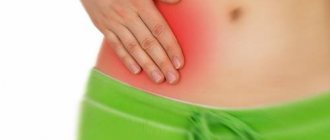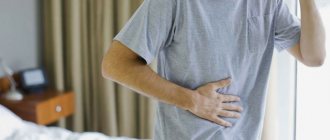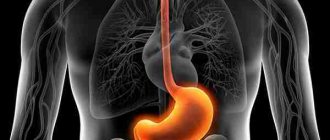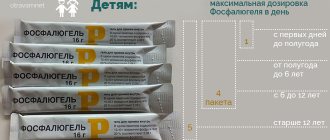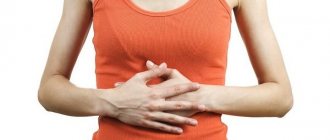Classification of esophageal diseases
The entire list of diseases of the esophagus is divided into groups depending on the nature of the pathology:
- congenital malformations - diseases detected in childhood, include absence of the esophagus and duplication, atresia, stenosis, joint fistulas with the trachea, shortening and expansion, diverticula, cystic formations;
- functional disorders (neuromuscular dysfunction) - paralysis, atony, cardiospasm, achalasia;
- inflammatory lesions - esophagitis and their consequences, peptic ulcer, stenosis - nonspecific and specific for tuberculosis, syphilis;
- vascular - varicose veins of the esophagus, angioma, hemorrhagic angiomatosis;
- benign and malignant tumors, precancerous diseases;
- traumatic injuries, including external and internal, burns and their consequences, ingress of foreign bodies.
In the structure of esophageal diseases, 60% are tumors, 10.8% are functional disorders, diverticula, scars after burns, and only 0.4% are esophagitis.
Causes
The causes of esophageal pathology are distinguished depending on the main factor of influence. Congenital - associated with a violation of the laying of the tube and its division into the trachea and esophagus, caused by a pathology of heredity, complicated by the mother's pregnancy, diseases of the mother's body, and are formed at the stage of embryonic development of the fetus.
Mechanical - caused by the ingestion of sharp objects by children, adults accidentally or with suicidal intent, fish bones, dry and hard crusts, insufficient chewing of food when eating hastily or the absence of good dentures in old age.
Items most likely to be swallowed by young children
Chemical - include frequent abuse of alcohol (poisoning with surrogates, acetic acid, technical liquids), spicy dishes, salty and pickled foods, strong coffee and chocolate, receiving a dose of nicotine through smoking and inhaling tobacco smoke, and using irritating medications.
Infectious - an infection enters the esophagus when swallowing secretions from the maxillary sinuses during chronic inflammation, from the palatine tonsils, or untreated carious teeth. Thermal - both overly hot and overly cold foods have the same effect.
Symptoms
Symptoms of pain in the esophagus differ depending on the underlying disease:
- painful to swallow. The symptom occurs unexpectedly, without apparent reason. At first, discomfort in the larynx occurs after excitement or rapid chewing of food. Problems when swallowing food are usually selective in nature. For example, drinking water may not cause any discomfort, while swallowing dairy products may cause pain. After eating, there is a pressing feeling in the upper part of the sternum, tachycardia, as well as difficulty breathing;
- belching. Occurs immediately after eating or after some time. Bends or physical activity can provoke an unpleasant symptom;
- pain. The esophagus can hurt due to stretching of the walls of the esophagus or involuntary contractions. The attack can last up to several minutes. Often pain in the esophagus radiates to the back, jaw, neck, ear;
- heartburn.
Pain when swallowing saliva may persist for several minutes
Symptoms of esophageal diseases
Diseases of the esophagus have common clinical symptoms, by which the doctor judges the location of the lesion. Let us analyze the main manifestations and their mechanism of occurrence. Heartburn is a burning sensation behind the sternum that radiates to the neck. Caused by the ingress of acidic contents onto the mucous membrane of the cardiac region from the stomach.
Patients about from the upper abdomen. Decreases after drinking water, swallowing saliva, and taking medications that neutralize hydrochloric acid in gastric juice. Accompanies dysfunction, esophagitis, gastroesophageal reflux disease (GERD).
Heartburn worsens after overeating, when bending forward, if a person takes a lying position
Odynophagia is the name given to the manifestation of pain in the chest when swallowing food. The symptom is caused by damage to the surface of the inner shell. It must be distinguished from painful spastic contractions of the esophageal muscles. It is observed in infectious esophagitis (herpetic and fungal), cancer, ulceration, and chemical burns. The pain becomes constant and excruciating for the patient.
The nature of the pain changes during the day, patients find it difficult to describe the symptom.
Pain due to muscle spasms is a sign of impaired motor skills. They occur both immediately after eating and independently (spontaneously). The intensity and persistence of pain leads patients to refuse food, fear, severe depression, and mental changes.
Regurgitation (belching) - caused by the return of a bolus of food into the oral cavity. It is not accompanied by contraction of the diaphragm muscles, as with vomiting, but accompanies heartburn.
It is observed when the esophageal tube narrows due to spasm, scars, and diverticula.
If caused by gastroesophageal reflux due to sphincter weakness, the patient feels a sour or bitter taste. The danger of regurgitation lies in the high risk of food particles getting into the trachea and bronchi. Patients develop a severe cough with an attack of suffocation. In the future, the development of aspiration pneumonia cannot be ruled out.
Dysphagia is difficulty swallowing food, especially dry foods rich in fiber. Some patients experience a paradoxical symptom - liquid food passes with greater difficulty than solid food.
Symptoms of esophageal diseases have their own characteristics for each pathology. To these are added: prolonged hiccups, increased salivation, putrefactive odor. We will look at them using the example of the most common diseases.
Differential diagnostics are carried out only by qualified specialists
Pain in the esophagus: causes
To determine whether pain behind the sternum has a relationship with the esophageal organ, one should monitor whether it is associated with swallowing or not.
- odynophagia – painful swallowing of food;
- dysphagia – difficulty passing a bolus of food (more about it).
If the pain is in no way related to swallowing food, such pain is called spontaneous. When chest pain is associated with swallowing, this indicates that the source is located directly in the esophagus and is accompanied by a violation of the internal walls.
Sometimes the esophagus hurts after vomiting. And when the esophagus hurts after drinking alcohol, it is caused by poisoning of the body.
Why does the esophagus hurt? The reasons may be the following:
- dysfunction of the esophageal tube;
- inflammatory reactions of the mucous membrane with reverse reflux of gastric contents (reflux esophagitis);
- malignant formations;
- hiatal hernia;
- wall diverticula (more details);
- esophageal achalasia ;
- narrowing of the tube lumen (stenosis);
- rupture of the esophageal wall due to injury or disease;
- developmental anomalies, etc.
Important! Symptoms increase as the disease progresses. If pain in the esophagus is not treated, the discomfort will increase: first there will be difficulty swallowing, then dysphagia will be complicated by pain and develop into odynophagia.
Functional disorders
A disorder of the functions of the alimentary canal is a weakening of its motor abilities without visible inflammatory or tumor changes. The main function of the esophageal tube is to pass the eaten piece into the gastric region. Digestion of food does not occur in the esophagus.
Spasm
The movement of the food bolus into the stomach is disrupted when the esophagus is spastic. Spasm occurs as a result of contraction of muscle fibers; it can affect any part of the thoracic or cardiac region ( cardiospasm ).
Dysphagia during spasm either intensifies or weakens. This condition lasts for a long time. Pain in the esophagus occurs during eating, rarely associated with food.
Atony
The opposite condition is called atony - this is a weakening of the muscles of the organ, which also makes it difficult for food to pass through. With atony of the walls, peristalsis is weakened, the eaten food slowly moves along the canal, stops in some places, sticks to the walls, then slowly continues moving.
The causes of impaired functions are often associated with psycho-emotional problems: anxiety, depressed mood, persistent depression associated with psychological trauma in the service or at home. Under other circumstances, the reasons cannot be determined.
Pain in the esophagus during belching: why it occurs
Belching pain in the esophagus provokes:
- frequent smoking;
- eating fruit on an empty stomach;
- sleeping with a full stomach;
- hot bath immediately after eating;
- fast food;
- carbonated drinks.
The listed factors lead to inflammatory processes in the area of the larynx and esophageal canal, the epithelial layer changes, and pain occurs. Belching empty air occurs with reflux esophagitis (more about this disease). Now it’s clear why the esophagus hurts. Next, you need to find out what to do if your esophagus hurts after eating.
Esophagus hurts: what to do if functions are impaired?
This condition requires immediate consultation with a doctor: conduct an examination to rule out serious illnesses. When the disorder is severe, it is sometimes necessary to visit a psychotherapist or psychologist. The doctor will determine the psychological state and identify the internal conflict that caused functional changes in the organ. With the help of psychotherapeutic methods, correction of this condition is achieved.
Symptomatic treatment is carried out by a general practitioner or gastroenterologist . Patients will be advised to eat in a calm, quiet environment, eat slowly, and chew foods thoroughly. Among medications, long-acting nitrates are highly effective.
Major diseases
Next, the main pathological conditions, their pathogenesis, symptoms and characteristics of the course are considered.
Achalasia cardia
The disease is also called “cardiospasm”. The reason is unknown. In pathogenesis, attention is paid to impaired communication of the esophageal muscles and dysfunction of nervous regulation.
In childhood, underdevelopment of the nervous apparatus of the esophageal tube was revealed. As a result, the opening of the lower sphincter and the food bolus is delayed.
Patients complain of a feeling of heaviness in the chest and epigastrium, bloating, and regurgitation. Washing down food with water helps push food through. Symptoms are not constant.
Occurs after swallowing foods containing a significant amount of fiber. Sometimes dry foods cause a less painful reaction than liquid foods. Chest pain with cardiospasm is very similar to angina pectoris, so middle-aged and elderly patients undergo an ECG check.
Dyskinesia
Functional disorders of the muscle tone of the esophagus manifest themselves in the form of dyskinesia. It accompanies an organic lesion, accompanies esophagitis, ulcers, but is possible without any anatomical damage. Ineffective motor skills are manifested by impaired food transport. The reason is a change in the regulatory role of the nervous system.
Signs such as belching air, heartburn, and intermittent chest pain in this case occur in people suffering from neuroses. The patients themselves indicate a connection between their well-being and the stress they have endured.
The description of the symptoms is accompanied by vivid figurative expressions: “something is twitching in the throat,” a feeling of a lump. Massage of the reflexogenic zone, restorative procedures, and a clear rest and work schedule help.
Gastroesophageal reflux disease
Another name for the disease is “reflux esophagitis.” Chronic inflammation of the esophageal mucosa is caused by the reflux of food with gastric juice from the stomach.
The main cause is considered to be weakness of the lower esophageal sphincter due to exposure to spicy foods, caffeine, nicotine, and damage to the vagus nerve. It is observed with diaphragmatic hernia, gastric ulcer, cholecystitis. Triggered by pregnancy.
There are:
- esophageal manifestations - heartburn, belching, difficulty swallowing, odynophagia, vomiting, hiccups;
- extraesophageal - a tendency to frequent colds, diseases of the bronchi and lungs, stomatitis, ENT diseases, caries, anemia.
Hiatal hernia
The disease is caused by displacement of the lower part of the esophagus (possibly part of the stomach, intestinal loops) through the expanded ring of diaphragm muscles from the abdominal cavity to the chest cavity. The cause is stretching of the connective tissue structures of the muscular apparatus of the diaphragm, increased pressure inside the abdominal cavity (with ascites), and inflammatory diseases of the esophagus.
Occurs in 0.5% of adults. It is important that in half of the cases the disease occurs without symptoms. The main manifestations do not differ from general esophageal symptoms, but retrosternal pain is of particular importance. Unlike cardiac ones, they are provoked by eating, bending forward, or the patient's supine position. Relief occurs after vomiting and belching.
Esophagitis
Esophagitis is quite rare. They accompany other lesions of the esophagus and stomach, injuries, hypovitaminosis, and iron deficiency conditions. The disease is considered acute if it lasts up to 3 months. More than six months of manifestations are classified as chronic. Intermediate periods are called subacute.
Specific inflammation occurs with syphilis, tuberculosis, and fungal infections. Manifests itself with all the above esophageal symptoms. With regurgitation or vomiting, it is typical to detect food that has just been eaten. There is a characteristic connection between chest pain and nutrition.
Esophageal diverticulum
Diverticula are saccular formations within the wall of the esophagus. By origin they can be pulsational (caused by increased internal pressure) and traction (with cicatricial changes in the esophagus and adjacent lymph nodes).
The protrusion of the wall can reach significant sizes and, by squeezing the tube, disrupt the passage of food. Manifests:
- gradual increase in dysphagia;
- putrid odor from the mouth from the decomposition of food stuck in the diverticulum;
- belching air and food;
- swelling in the neck immediately after starting to eat and the inability to swallow further until the diverticulum is emptied.
Barrett's esophagus
The disease is considered precancerous because it is caused by changes in the cells of the inner layer of the esophagus (metaplasia). The typical cellular composition is replaced by sections of intestinal epithelium. The exact cause has not been established, but there is a connection with a long-term inflammatory process in esophagitis, reflux disease, and diaphragmatic hernia.
Any disease of the esophagus can become a provoking factor for Barrett's esophagus if left untreated.
Patients complain:
- for persistent pain in the throat and chest;
- hoarseness of voice;
- belching with sour contents;
- heartburn;
- constant cough.
Benign tumors
Benign neoplasms of the esophagus arise from epithelial and other cells of the wall. They grow slowly and do not appear for a long time. The most common are leiomyomas and cysts.
The main symptoms begin to worry patients when the tumor grows significantly and there is difficulty swallowing food. The sensation of a foreign body causing nausea and vomiting is characteristic.
Malignant neoplasms
Any of the above reasons can lead to a cancerous tumor of the esophagus. The initial period lasts up to two years and occurs without symptoms. The first signs are disturbances in the passage of food, which is caused by the rather large size of the tumor.
Dysphagia increases gradually: at first the patient cannot swallow hard foods, then difficulties arise when eating liquid foods, and increased salivation. General signs of intoxication appear: weakness, lack of appetite, weight loss.
Pain in the chest increases significantly when swallowing, sometimes radiating to the back. They become constant and painful in the severe stage of the disease. Alcoholism and smoking increases the risk of esophageal cancer by 12 times.
Injuries to the esophagus
Burns and injuries to the esophagus occur in accidents, mistaken use of acids or alkalis, technical liquids while intoxicated or for the purpose of suicide. Unsupervised children swallow sharp objects.
A chemical burn causes necrotic changes in the wall. The patient’s condition depends on the depth of the damage. With severe rapid necrosis, the patient is in shock, and at the same time there are signs of internal bleeding. Swallowing is impossible. Swelling of the tissue causes complete obstruction of the lumen.
Traumatic injury can occur when endoscopic methods are used in the diagnosis of other diseases. Injuries to the esophagus must be excluded in cases of trauma to the chest organs.
Developmental defects
Abnormalities of the esophagus are caused by disturbances in the development of the fetus in the first trimester of pregnancy. During this period, the common tube of the esophagus and trachea is laid and then divided. Therefore, vices are often linked. Discovered in early childhood. Immediately after the start of feeding, esophageal atresia is detected: the child is suffocating due to milk entering the respiratory tract.
Often esophageal defects accompany developmental defects of other organs and systems.
Causes of esophageal obstruction
All possible causes of obstruction of the esophagus can be reduced to several main groups.
Malignant neoplasms of the esophagus itself or mediastinal organs (trachea, large bronchi, lymph nodes). As the tumor grows, the lumen of the organ is blocked, disrupting the movement of the food bolus.
Post-burn stenoses . These are scar narrowings of the esophagus left after chemical burns. They occur after accidental or intentional ingestion of concentrated acids or alkalis. Alkalies are especially dangerous in this regard: unlike acids, they do not form a scab that prevents the substance from penetrating deep into the wall of the organ, but, on the contrary, loosen it. Because of this, burns are deeper and have more serious consequences.
Recurrent esophagitis . These are chronic inflammations of the esophagus caused by one reason or another. Constant inflammation sooner or later leads to scar changes, which, in turn, lead to a narrowing of the lumen of the organ.
Esophageal rings . These are thin concentric protrusions into the lumen of the esophagus, which include all three layers of the wall: mucous, submucosal and muscular. The reasons for their appearance are not fully known. Some authors suggest that these are inflammatory changes, others believe that esophageal rings are associated with impaired motility of the organ. Most often they are asymptomatic, but if they form in large quantities, they can disrupt the patency of the esophagus.
Congenital pathologies . The so-called esophageal atresia is a developmental defect that is detected in the coming hours after the birth of the child. An operation is required to re-form the esophagus.
Others _ This group includes such relatively rare causes of esophageal obstruction as tuberculosis, scleroderma, tertiary syphilis, trauma and foreign bodies, esophageal diverticula and other pathologies.
Diagnostics
Diseases of the esophagus cannot be identified based on clinical signs alone. Modern conditions make it possible to conduct an accurate examination. What matters is the complex of information received.
In conclusion, the radiologist provides data based on the results of a series of images in an oblique projection
Fluoroscopy with ingestion of a contrast agent and a series of images helps to make a conclusion when producing radiographs in oblique projections. The front and rear views do not allow us to see the esophagus, since it is covered by the shadow of the mediastinum.
The method is important in diagnosing diaphragmatic hernia, determining the location, size of the lumen, the presence of filling defects, narrowings due to diverticula, tumors, and cardiospasm. The direction of movement of the contrast can confirm gastroesophageal reflux.
During the study, the patient's position is changed from vertical to horizontal. Cardiospasm is confirmed by the picture of sphincter narrowing and expansion in the upper sections.
Esophagoscopy is a method that allows you to visually examine all parts of the esophagus. If necessary, a targeted biopsy is performed using a fibrogastroscope and foreign bodies are removed. The condition of the mucous membrane (the presence of inflammation, ulcers, tumors), sphincters, the size of the lumen and patency is assessed, and is prescribed for any dysphagia.
Biopsy is a method of intravital early diagnosis of tumor and epithelial metaplasia. Cytologists study the morphological picture of changes, the degree of degeneration, and the type of tumor.
Daily pH-metry is used to register the role of acid reflux into the lower parts of the esophagus in pathology. A special pH probe records the acid-base balance throughout the day. Computed tomography and magnetic resonance imaging are used if a tumor or enlarged lymph nodes are suspected.
Esophagotonocymography - includes the simultaneous use of several devices (kymograph, Marey's capsules, pressure sensors, ECG). Used to study esophageal motility in functional disorders. Identifies areas of tone disturbance.
Functional testing is important in identifying gastroesophageal reflux. Standard kits are used to help control acidity and pressure inside the esophagus. Radioisotope technique is necessary for diagnosing a tumor; the 32R isotope is used, which accumulates in the affected cells and is then visible during scanning.
Timely diagnosis allows not only to identify pathology, but also to determine how to treat a specific disease.
Treatment
The choice of treatment tactics for diseases of the esophagus is individual for each specific case. What is common is the need to support the normal mental state of patients, since impaired swallowing dramatically changes mood, causes severe depression, and suicidal attempts.
Diet plays a significant role
For severe pain and heartburn due to esophagitis, fasting is used for a period of no more than two days. Then they switch to a gentle diet. The patient is recommended to be fed 6 times a day, in small portions. Meals should contain enough protein, vitamins, carbohydrates, and a reduced amount of fat.
Use ground meat additives and semi-liquid porridges, ground through a meat grinder. Dairy products are used depending on concomitant stomach lesions. Broths and soups should not contain irritating substances or seasonings. For esophagitis and ulcers, cold drinking is recommended.
Vegetables and fruits are allowed after inflammation has subsided, first in pureed form. Prepare steamed casseroles and omelettes. The patient is strictly prohibited from: alcoholic beverages, strong coffee and cocoa, citrus fruits, spicy and fried foods with crusts, fresh baked goods, fatty culinary products.
Changing the regime requires eliminating smoking, switching to work without occupational hazards, and heavy physical activity. It is recommended to sleep with the head of the bed elevated.
Drug treatment
In order to calm the patient, sedatives are prescribed. For cardiospasm, antispasmodics are used, attacks are relieved with nitrates, a group of calcium antagonists. Impaired sphincter motility is treated with drugs with anticholinesterase activity.
In case of increased acidity, antacids (Maalox, Phosphalugel) are required. Almagel-A with anesthesin is used for local anesthesia. For reflux esophagitis, drugs that help block H2-histamine receptors (Famotidine, Ranitidine) and improve the condition of the sphincter (Cisapride, Cerucal) are indicated.
Barrett's metaplasia requires similar drugs to combat the cause, but larger dosages are used
For all conditions, antibiotics and anti-inflammatory drugs are prescribed to fight infection. Specific esophagitis is treated with antituberculosis drugs and antisyphilitic drugs.
For esophageal cancer, medications with a cytostatic effect are included in combination treatment in combination with radiation therapy.
A state of shock due to a burn of the esophagus is treated in the intensive care unit with intravenous administration of Reopoliglyukin, cardiovascular drugs. Antibiotics are required to prevent pneumonia. For anemia, transfusion of blood substitutes is indicated.
Surgical methods
Surgical treatment is prescribed to patients with achalasia if it is impossible to act on the sphincter with medication. Muscle dissection or a course of cardiodilation procedures with a special balloon are performed. The insertion of a probe with an inflating balloon to compress the veins is used for esophageal variceal bleeding.
Esophageal diverticula are treated only surgically if they are large and obstruct patency. For an esophageal hernia, a fundoplication operation is performed (an artificial valve is formed), and the muscle ring is strengthened with tissue plastic surgery. In the case of esophageal cancer, the tumor and all or part of the esophagus and lymph nodes are removed. Cytostatics and radiation therapy are used simultaneously.
Congenital anomalies are operated on in early childhood, since it is necessary to create conditions for the child’s nutrition. Typically, the intervention consists of two stages: first, a stoma (outlet) of the stomach is created on the surface of the abdomen, then, after a few months, plastic surgery of the esophagus is performed, its ends are connected to each other, with the stomach.
For burns, the bougienage technique for stretching scars deserves special attention. The method is also used in the postoperative period to prevent stenosis. Under local anesthesia, dense rubber probes (bougies) of different sizes are inserted into the patient, starting with a small diameter. All medications are used simultaneously to improve muscle elasticity.
People's Councils
A person with problems with the esophagus has to adhere to a diet and nutrition regimen all his life. Treatment with folk remedies is indicated outside of exacerbation. It does not replace medications. Herbal teas with anti-inflammatory effects help, relieving spasms and protecting the mucous membrane of the esophagus and stomach.
It is better to discuss the use of medicinal herbs with your doctor
In herbal medicine it is recommended:
- herb St. John's wort, yarrow, celandine;
- chamomile flowers, calendula;
- plantain leaves;
- seeds, roots and leaves of forest angelica;
- dog-rose fruit.
To protect the surface of the esophagus and stomach, a decoction of flax seeds and oats is used. To relieve persistent hiccups, lubricate the throat with oregano oil and inhale with it.



